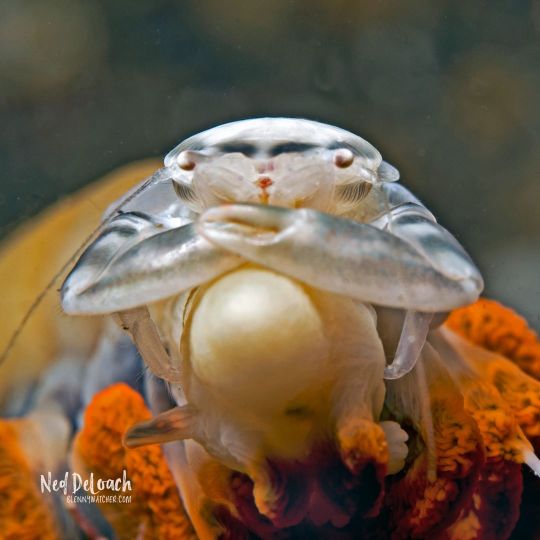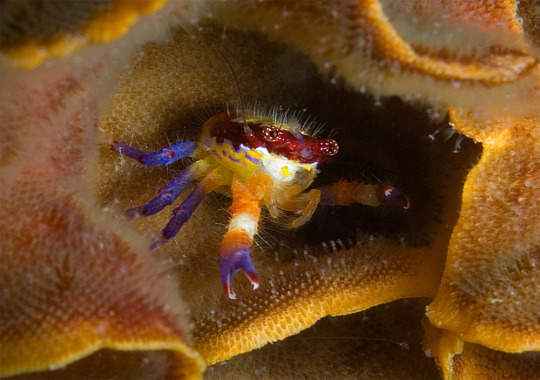#Galatheoidea
Text

Three-lobed Porcelain Crab
#three lobed porcelain crab#porcelain crab#crab#Porcellanella triloba#Malacostraca#Decapoda#Pleocyemata#Anomura#Galatheoidea#Porcellanidae#Porcellanella#upl
4 notes
·
View notes
Photo

Two squat lobsters (Galathea squamifera) in a rock pool at West Runton, north Norfolk. The crustaceans are closely related to hermit crabs and swim or scuttle backwards when disturbed.
Photograph: Rupert Higgins
(via The week in wildlife – in pictures | Environment | The Guardian)
#Black Squat Lobster#Galathea squamifera#Galathea#Galatheidae#Galatheoidea#Anomura#Decapoda#Malacostraca#Crustacea#crustacean#lobster#England#United Kingdom
16 notes
·
View notes
Text
Fossil crustaceans as parasites and hosts
Fossil crustaceans as parasites and hosts
Who would like to carry a parasite? I bet not many people would like to have one or more. They are nevertheless very common in humans and in other organisms, and can affect entire food webs including keystone species. They tend to be small compared to the host and the vast majority of them are soft-bodied. Despite their small size and soft appearance, they can affect the host substantially, for…
View On WordPress
#Amber#bopyridae#carapaces#carbonates#cenozoic#copepods#crab#crustacean#Crustaceans#decapods#Fossil#fossil crab#Fossil Crabs#fossil shrimp#fossil shrimps#fossils#galatheoidea#goniodromites laevis#holocene#infestation#isopods#Jurassic#kanthyloma crusta#larvae#late jurassic#lobster#lobsters#Mesozoic#mid cretaceous#Miocene
0 notes
Note
Squat lobsters are dorsoventrally flattened crustaceans with long tails held curled beneath the cephalothorax. They are found in the two superfamilies Galatheoidea and Chirostyloidea, which form part of the decapod infraorder Anomura, alongside groups including the hermit crabs and mole crabs.
lovely biography about the BEST animal on Earth
2 notes
·
View notes
Photo

Squat Lobster | Galatheoidea
(by Rowland Cain)
108 notes
·
View notes
Photo

Red crabs swarm Southern California, linked to ‘warm blob’ in Pacific
Red crabs, by the thousands, have invaded Southern California beaches, washing ashore from San Diego to Newport Beach. Sea surface temperatures some 4-7 degrees warmer than normal, possibly connected to a radical change in a Pacific ocean weather pattern, are likely driving the crabs northward away from their typical habitat....
The crabs, resembling miniature lobsters too small to eat, are known as tuna crabs or pelagic red crabs. “Typically such strandings of these species in large numbers are due to warm water intrusions,” said Linsey Sala of Scripps Institution of Oceanography, UC San Diego.
The crustaceans usually inhabit the west coast of Baja California, the Gulf of California, and the California Current (spanning from offshore the U.S. West coast down to southern Baja California), a Scripps news release said.
In addition to the crabs, the warm Pacific coastal waters have drawn northward a number of other creatures seldom or never previously seen, which last fall included: a live ocean sunfish and warm-water blue shark in the Gulf of Alaska, mahi mahi off the coast of Oregon, a Pacific sea turtle common in the Galapagos near San Francisco, and marlin in the waters off Southern California.
#Pelagic Red Crab#Pleuroncodes planipes#Pleuroncodes#Munididae#Galatheoidea#Anomura#Decapoda#Malacostraca#Crustacea#Arthropoda#crab#marine life#ocean#Pacific Decadal Oscillation#California#Pacific Ocean
19 notes
·
View notes